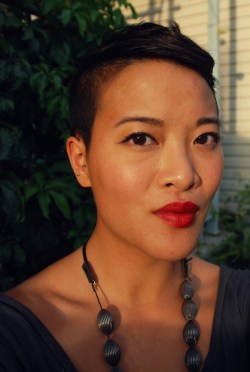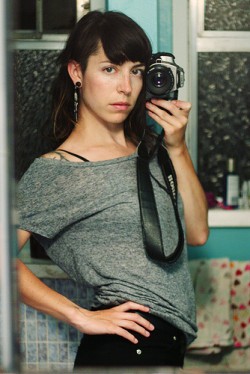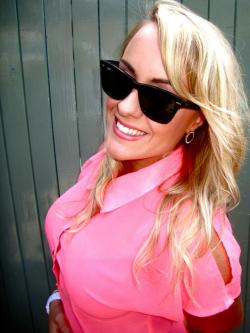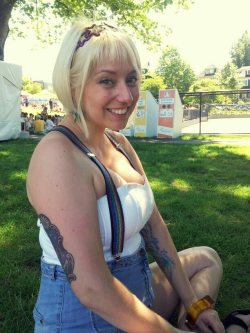Sometimes life clicks. You’ve been struggling with yourself for ages and are slowly getting a grasp on the situation. Little by little you fit your pieces together until there’s a silhouette of who you think you are. With each bit of understanding you sit up a bit higher until you’re on top of the world and nothing can stop you. Until you go on a date and a comment completely fucks you over.
“Actually, I don’t think this is going to work out. You’re a bit too femme.”
I had never been put into a tailspin by a word before. The word femme had existed in my world but it had never been heaved at me as a pejorative. If she had put it in crasser terms and said, “Honey, I am not attracted to you. FUCK OFF!” I would have taken it better; instead I was handed a rejection couched in a backhanded compliment, lumped into a category I thought no longer existed and summarily dismissed because of it. I was livid, and my god I would have stuck a stiletto up her ass if given the chance.
This was a few years ago, when I was coming out. When I learned that by accepting the label gay I had somehow opened myself up to having a thousand other labels tacked on, some of which I could choose, but plenty of which I couldn’t. There seemed to be so many more wonderful words and phrases to describe the more masculine queers: Androgynous. Butch. Boi. Masculine-of-centre. All of these powerful terms that are seen as compliments and imply you fit into this subculture. Although I often read their complaints about failing to fit into a heteronormative world, the only thing I could think was, “Hey… at least you fit into one of them?”
Meanwhile I was stuck with “femme,” a label I couldn’t own. Even though femme tends to be the blanket term for queers that aren’t androgynous or masculine, the only queerettes I saw that happily claimed the title were unabashedly feminine. They were ladies that preened and prepped. They showed up on your screen in lipstick and lingerie. They had their pick of either world, these perfect girls with curves that caused boys and bois to do a double take. Some might call them lipstick. Some might call them high-maintenance. Some might call them straight. I was positive I wasn’t one of them and most of all, I doubted they would consider me one of them.
 Some of my friends laughed at me when I told them I was stressed out about being seen as femme. To them I was just Kristen, as labeled or unlabeled as when we first met. “Why should it matter what other people call you?” “At least you get by.” “If they are so obsessed with your grouping, you don’t want to waste your time on them!” “Labels don’t matter!” But unless you’re at a dyke bar wearing Mary Janes in a sea of androgynous hipsters clad in leather jackets, skinny jeans and Chucks, it’s hard to empathize, especially when you’re debating whether or not there was a point to coming out that night. Or to coming out at all.
Some of my friends laughed at me when I told them I was stressed out about being seen as femme. To them I was just Kristen, as labeled or unlabeled as when we first met. “Why should it matter what other people call you?” “At least you get by.” “If they are so obsessed with your grouping, you don’t want to waste your time on them!” “Labels don’t matter!” But unless you’re at a dyke bar wearing Mary Janes in a sea of androgynous hipsters clad in leather jackets, skinny jeans and Chucks, it’s hard to empathize, especially when you’re debating whether or not there was a point to coming out that night. Or to coming out at all.
I wondered if I should change my hair or stop wearing heels, or if I should butch it up a little bit in order to get a date and be taken seriously. I was antsy and fidgety about labels because it didn’t make sense that I could be called so many things when I hadn’t physically changed at all.
I know I was prejudiced against femmes when I was thinking these things, but at the time the only thing I could do was brood. I had no femme role models who looked and thought like me, who were brash and confrontational but still painted their toenails. There are lovely anthologies that embrace femme identity, but ink and paper only give so much solace when you’re trying to come to terms with yourself in a flesh and blood world. Surely other people felt excluded for being “girly,” but how the fuck do you compare experiences when you can’t pick your allies out of a crowd? I wanted to learn from other femme-identified queers, but it takes courage — more than I had — to seek out that camaraderie when the closest and most visible examples of yourself are being criticized as not representative.
I harboured reservations that would creep up whenever I heard the word femme. I remember hovering my cursor over the Femme checkbox on my Autostraddle Social profile a little longer than I should have. Even on a website I love and love writing for, sometimes I worry if I’m doing it right. Like Jeanette Young writes for the Link’s Women’s Issue, “We are often seen as heteronormative, apolitical, less radical, and less queer in a community where being visible and valued depends on being masculine or androgynous.”

The meaning of the word changed for me once I started to see self-described femmes who embodied none of those negatives Young describes. Through tumblrs and blogs, I could see a femme’s exterior and also hear her voice. Just because you could paint on a cats-eye or work a pencil skirt didn’t mean you couldn’t also be a radical with political beliefs. Owning your curves (or lack of curves) had nothing to do with the male gaze, in the same way that being less politically radical didn’t stop me from being feminist, and staying true to my style and self expression didn’t stop me from being gay. Saying it now sounds so ignorant, but I could only see the strength of the word femme once I understood the breadth of its spectrum.
I run a little fashion blog called Tomboy Femme over on Tumblr, inspired by this struggle with labels. I call myself a tomboyfemme because I think it describes where I sit at the centre of a continuum – compared to most female-bodied queers, I’m femme as hell, but in a group of heterosexual women, I’m immediately called a tomboy. Tomboy femme is a term I’m comfortable with others claiming and defining for themselves, but for me it describes the comfortable niche I’ve settled into between butch and femme, representing my queerness as I feel I want to. Still, it can be quite tough around queers who think I look too straight. – Malloreigh
“So, I didn’t always identify as femme, because I didn’t know it was an option, because I didn’t know it could be positive,” writes Connie Laalo, a woman who is an unabashed lesbian. And a queer. And a femme. Though our paths never crossed while we both lived in Vancouver, we eventually met online when a mutual friend posted a link to Beyond Lipstick, Laalo’s thesis for Ryerson University’s MA Fashion program, and as soon as we started talking I knew she got me. Unlike other projects that simply want to put faces to the name, Laalo wanted to learn how femmes saw themselves and each other in their own terms.
I am not trying to tell a story about femme identity – I am just trying to facilitate the articulation of the femme experience. There are participants who have a vastly different concept of femme than I do – but I completely believe that each experience is valid and authentic and I feel I have a responsibility to include every voice that participates in my project. I really think the strength of Beyond Lipstick comes from the multiplicity of expressions. – Connie
So she did. She gathered anonymous portraits and the answers to three simple questions:
What is your definition of femme?
Do you represent your sexuality through your clothing?
How do you identify another femme?

Her small sample of femmes “expressed a theme of empowered, conscious femininity that was intentional in its choice of self-representation.” The major thread was that in the face of adversity, of judgement, no fucks were given. Here were women who knew that they might be judged or read as straight, but they had to dress their truth. Some chose hyper femininity, relying on silhouettes and garments from the 1950s. Others simply refused to dress more masculinely than they were comfortable with. It showed a spectrum of style in which no representation of femme was in any way more correct, as long as the wearer felt right.
The submissions were as varied as the submitters themselves. Some used conventions that spoke to a background in feminist and gender theory. Others wrote with typos, slang and crass terms. All opinions were equally valid. Quotations have been preserved as submitted.
Someone who does not identify as a butch, androgynous, or otherwise masculine labels with a female body.
I am strong in my sense of self, not caring what the world at large thinks, yet painfully aware that many perceive me to be aloof and pretentious when I walk in the room in towering heels, perfectly buffed appearance and fitted dress.
I think I represent queerness less through clothing and more through my presence as a whole. By clothes, I get read as straight, and aesthetic definitions of femme piss me off to no end. It is not glitter or makeup or a pencil skirt that makes me femme. When I wear men’s jeans and a tank top, I’m femme. But I think most often, my gender expression is femme in that it’s feminine clothes with big presence, taking up space, walking confidently, looking you in the eye, checking you out, coming on to you. It’s a tension between what is traditionally “masculine” and what’s “feminine,” and really everything you think is either is both.
There is nothing superficial or shallow about it. It”s NOT something some man or patriarchal society makes me do. It”s my self expression, and just one of many in our multi faceted world.
I dress up in a way that makes me feel comfortable as I am and follows my own personal style of a mixed look depending on the day and occassion.
i love to dress in sexy, feminine clothing, although certainly not dresses or high heels necessarily
my flamboyantly feminine excess queers me automatically in any context. While my clothing/style may not scream lesbian, it most definitely says something
No, there is no way to tell I’m gay via my clothing and to try to do so would be going against who I am.
This is my sexuality of femme, I am more polished than any straight woman I know.

In completing her thesis and imagining Beyond Lipstick’s future as an exhibit or a film, the project caused Laalo to rethink its strengths and pitfalls. In her original call for submissions she was only looking for femme lesbians. She corrected her call-out and asked for all femme-identified women, trans* inclusive. “I think many individuals can connect and identify with femme as an empowering interpretation of femininity that is essentially queer.” Her research made her realize that the term could encompass men, bisexuals and straight women as well, so Laalo is still looking for new submissions. She wants to expand her portraiture collection to represent femmes of colour, genderqueer and trans* femmes, femmes with disabilities, elder femmes, fat femmes, working class femmes, male femmes and every other incarnation that needs to be acknowledged.
Although the submissions showed that femme was as powerful as its butch counterpart, the answers revealed that we still haven’t overcome our greatest challenge. “I usually say that someone is gay until proven straight. I will flirt with any girl until she tells me she isn”t [sic] interested. How else am I going to find out?” asked a Beyond Lipstick submitter. Femme (in)visibility is as difficult a problem as ever and will probably continuously haunt us. Effing Dykes pondered the idea, asking readers what to do given that femmes and femme-lovers seemed to be missing each other completely. The only thing I can suggest is that people who fall under the umbrella learn to share their space and find friends beneath it — that they try to be out as an everyday role model, not for the doubters or the critics, but instead for themselves and the closeted femme that doesn’t know she can exist. Whether people choose to wear a rainbow or correct an assumption, the only way femmes can make progress is to talk about it and do something. Laalo’s original call-out put it best: “We are only invisible if we sit by the sidelines, allowing others to be the face of lesbian identity.”
If you’re lucky enough to have a ticket to Baltimore this weekend you can attend FemmeCon 2012. From August 17th through 19th you have the opportunity to share stories and experiences with femmes, Femmes, fems and allies. The three-day fest brings out performers, vendors and speakers embracing their femme-inity. Fit for a Femme covered her attendance two years ago, boasting that “you’re just not prepared for that kind of awesome until you see for yourself how much momentum can be built on the strong and lovely backs of femmes of all stripes” to much applause by Autostraddlers. Laalo will be participating in FemmeCon and giving a Saturday morning talk on Beyond Lipstick. There’s still time to register!
Hopefully other femmes have already overcome their own insecurities, but if not, just remember there’s a Google’s worth of people out there like you. Or keep Ivan E Coyote’s “Hats Off to Beautiful Femmes” bookmarked as a mantra whenever that irksome doubt comes up.
I want to thank you for coming out of the closet. Again and again, over and over, for the rest of your life. At school, at work, at your kid’s daycare, at your brother’s wedding, at the doctor’s office. Thank you for sideswiping their stereotypes.
I never get the chance to come out of the closet, because my closet was always made of glass. But you do it for me. You fight homophobia in a way that I never could. Some of them think I am queer because I am undesirable. You prove to them that being queer is your desire.
* Please note. I’ve included photos of Beyond Lipstick participants that were submitted to Autostraddle. The project is anonymous and no contact information was stored. I recognized faces and asked for permission to use their pictures in the capacity of Autostraddle Contributing Editor. Connie Laalo’s work has not been compromised.
Special Note: Autostraddle’s “First Person” personal essays do not necessarily reflect the ideals of Autostraddle or its editors, nor do any First Person writers intend to speak on behalf of anyone other than themselves. First Person writers are simply speaking honestly from their own hearts.







